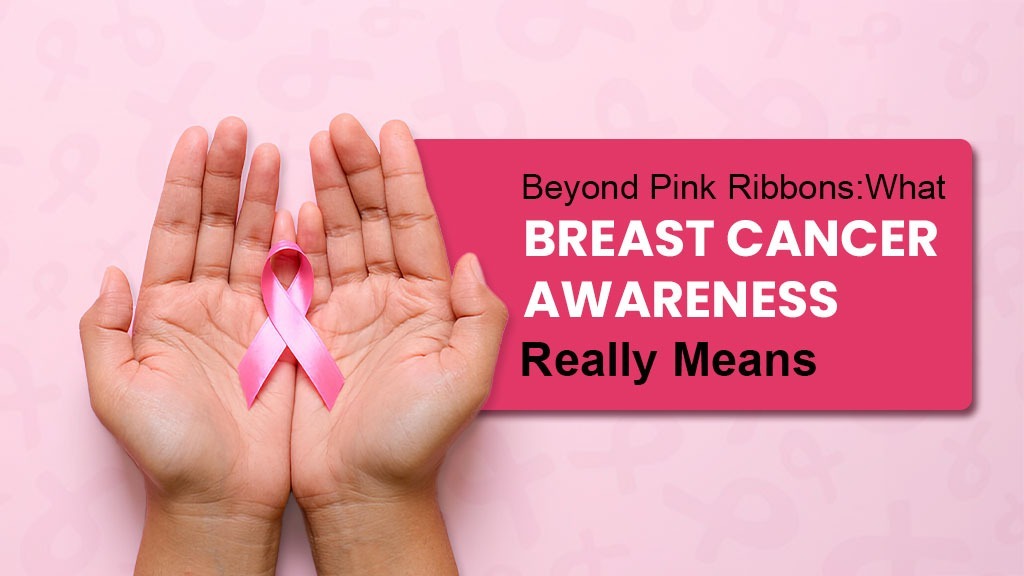
Beyond Pink Ribbons: What Breast Cancer Awareness Really Means

Introduction
They say a pink ribbon speaks a thousand words: hope, solidarity, and survival. Every October, the world dresses in pink, and campaigns flood our media with promises of awareness. But for many women living in small towns, and especially those who lack access or confidence to speak up, the ribbon can feel like a superficial token. True awareness is far more than a symbol. It means early detection, emotional support, sustained action, and dismantling barriers to care.
More Than a Symbol
Pink ribbons are powerful. They show the world we care. They bring visibility. They let survivors know they are not alone. But when the ribbon is all we see, we risk turning awareness into an aesthetic, something to wear rather than live.
A ribbon does little if there is no affordable screening, no nearby diagnostic center, no financial support for treatment. A ribbon alone won’t reach women in remote villages or destigmatize conversations in households where cancer is whispered about. True awareness must include access and education, so that people go from seeing pink to taking pink seriously.
The Lifeline of Early Detection
Medical studies consistently show that detecting breast cancer early drastically improves survival rates. According to the World Health Organization, when breast cancer is detected in Stage I, five-year survival rates can exceed 90%. Conversely, detection at later stages often leads to more complex, costly treatments and worse outcomes.
Yet many women delay screening. Why? Fear. Lack of awareness. Distance to hospitals. Cost. A lack of female health professionals in rural areas. A belief it “won’t happen to me.”
In one village health camp I visited, a woman in her 50s said she never thought screening was for her. She had heard of mammograms in cities, but in her town the nearest center was two hours away. The cost, plus a day off work, seemed impossible. She chose to ignore a small lump. By the time she visited a hospital, the cancer had advanced.
This is why awareness must include mobile screening units, subsidised diagnostics, and outreach programs. At Festivals For Joy, we actively bring Cancer screening camps and free early detection services to people who cannot afford them. Similarly, programs like Breast Cancer Awareness India actively run campaigns and screening drives across the country, helping women detect breast cancer early and access timely care
Behind the Diagnosis: Emotional Realities
A cancer diagnosis is not only physical. It comes with emotional upheavals: fear, guilt, shame, and isolation. Many women carry the weight silently, especially in societies where open talk about illness is taboo.
Survivors often say: “The hardest part wasn’t the chemotherapy, it was the silence around me.” They speak of nights crying alone, the secret dread of asking for help, and of hiding scars from partners or children. In contrast, a supportive community, a phone call from a counsellor, a peer group meeting, these can tilt the balance toward resilience.
Real awareness must normalise emotional care, trauma counselling, and peer networks. It must teach families how to listen, not lecture. It must believe that healing is more than physical remission.
The Gap Between Campaigns and Continuity
Breast Cancer Awareness Month (October) often bursts with energy: marathons, pink merchandise, and social media hashtags. But for many, November and December come, and the momentum fades. Without sustained programs, many women revert to neglect.
A campaign that raises money for one month but does not fund ongoing screening, treatment, or education is a short burst of light in a long, dark fight. Policies must back up passion. Governments, hospitals, NGOs must adopt continuous screening drives, subsidised treatment, insurance coverage, training for local health workers, and community education year-round.
Reaching the Margins
Cancer doesn’t hit only in cities. Women in remote or marginalised communities are at higher risk of late diagnosis. Awareness that doesn’t reach them is incomplete.
We need community health workers trained in breast health, mobile diagnostic vans, partnerships with local NGOs, and culturally sensitive education materials in regional languages. Simple tools like pictorial self-exam guides can bridge literacy barriers. Trust matters. If a woman fears being judged, she won’t show a symptom. If she’s never been invited to a camp, she won’t attend.
What You Can Do — Move Beyond the Ribbon
- Get screened annually or as recommended. Don’t wait for campaigns.
- Encourage women around you mothers, sisters, neighbours to do the same.
- Support NGOs and programs that bring screening to remote areas (like those by FFJ).
- Donate to sustainable healthcare-access models, not just campaign merchandise.
- Share stories of survivors, of challenges, of hope to humanise the cause.
- Advocate with policymakers for cancer care support, insurance, and infrastructure.
Why This Matters
When breast cancer is talked about only in October, many lose sight of it the rest of the year. But every day, women are diagnosed. Every day, delayed detection steals lives. Awareness must be a long walk, not a spotlight.
The pink ribbon was never meant to be just decoration. It should be a call and an invitation to real understanding, deeper care, and relentless action. When that happens, awareness becomes life-saving. And then, when you see a ribbon, you won’t just think “breast cancer month” you’ll see hospitals, counsellors, outreach teams, survivor stories, and the hands that reach out to help.
Let’s make our awareness count not just for October, but for every woman, every day.
